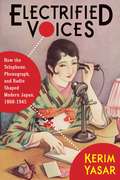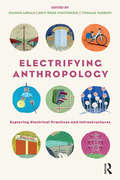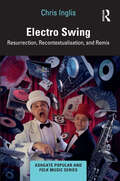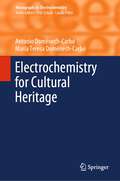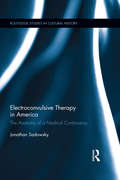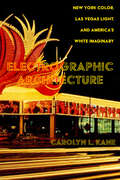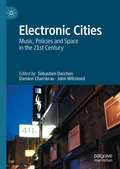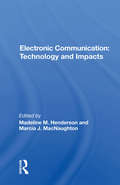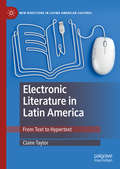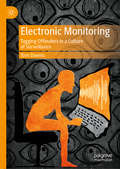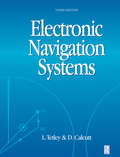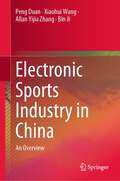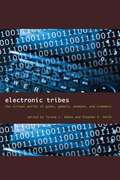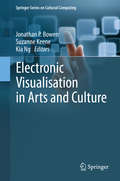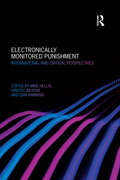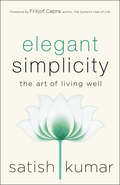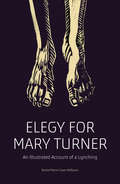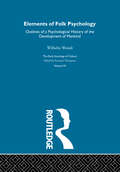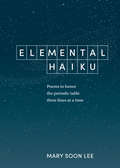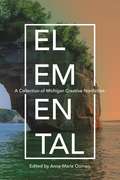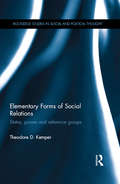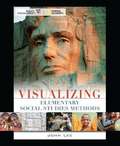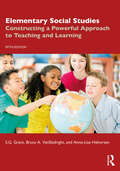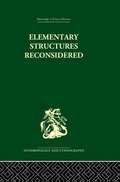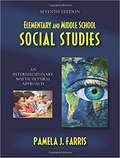- Table View
- List View
Electrified Voices: How the Telephone, Phonograph, and Radio Shaped Modern Japan, 1868–1945 (Studies of the Weatherhead East Asian Institute, Columbia University)
by Kerim YasarLong before karaoke’s ubiquity and the rise of global brands such as Sony, Japan was a place where new audio technologies found eager users and contributed to new cultural forms. In Electrified Voices, Kerim Yasar traces the origins of the modern soundscape, showing how the revolutionary nature of sound technology and the rise of a new auditory culture played an essential role in the formation of Japanese modernity.A far-reaching cultural history of the telegraph, telephone, phonograph, radio, and early sound film in Japan, Electrified Voices shows how these technologies reshaped the production of culture. Audio technologies upended the status of the written word as the only source of prestige while revivifying traditional forms of orality. The ability to reproduce and transmit sound, freeing it from the constraints of time and space, had profound consequences on late nineteenth-century language reform; twentieth-century literary, musical, and cinematic practices; the rise of militarism and nationalism in the 1920s and 30s; and the transition to the postwar period inaugurated by Emperor Hirohito’s declaration of unconditional surrender to Allied forces—a declaration that was recorded on a gramophone record and broadcast throughout the defeated Japanese empire. The first cultural history in English of auditory technologies in modern Japan, Electrified Voices enriches our understanding of Japanese modernity and offers a major contribution to sound studies and global media history.
Electrifying Anthropology: Exploring Electrical Practices and Infrastructures (Criminal Practice Ser.)
by Brit Ross Winthereik Thomas Yarrow Simone Abram Anjan SarkarWhat kinds of expertise and knowledge relate to electricity, and where is the space for alternative voices? How can the new roles for electricity in social and cultural life be acknowledged? How can we speak about ‘it’ in its own right while acknowledging that electricity is not one thing? This book re-describes electricity and its infrastructures using insights from anthropology and science and technology studies, raising fascinating questions about the contemporary world and its future. Through ethnographic studies of bulbs, bicycles, dams, power grids and much more, the contributors shed light on practices that are often overlooked, showing how electricity is enacted in multiple ways. Electrifying Anthropology moves beyond the idea of electricity as an immovable force, and instead offers a set of potential trajectories for thinking about electricity and its effects in contemporary society. With new contributions on an emerging area of research, this timely collection will be of value to students and scholars of anthropology, science and technology studies, geography and engineering.
Electro Swing: Resurrection, Recontextualisation, and Remix (Ashgate Popular and Folk Music Series)
by Chris InglisElectro swing is a relatively recent musical style and scene which combines the music of the swing era with that of the age of electronic dance music. Chris Inglis considers key questions about electro swing’s place in contemporary society, including what it may mean for a contemporary genre to be so reliant upon the influences of the past; the different ways in which jazz may be presented to a modern audience; how one may go about defining jazz in todays postmodern world; and how this emergent genre may be analysed in terms of the wider issues of race and class consumption.
Electrochemistry for Cultural Heritage (Monographs in Electrochemistry)
by Antonio Doménech-Carbó María Teresa Doménech-CarbóThis monograph overviews the importance of electrochemistry in the field of cultural heritage, including archaeology, conservation and restoration topics. The application of electrochemical techniques in these domains have experienced a notable growth during the last ten years, in particular with regards to the elucidation of composition, manufacturing techniques and chronology of archaeological artefacts. This book describes the application of solid state electrochemistry techniques for the use of samples at the nanogram level from paintings, metallic, ceramic, glass, glazed, wooden, and other objects, and it also includes the description of new dating procedures for archaeological objects made of these materials. It is a valuable contribution to the field of cultural heritage and will be of great interest to archaeologists, conservators and restorers as well as to physicists and chemists working on the scientific examination of works of art.
Electroconvulsive Therapy in America: The Anatomy of a Medical Controversy (Routledge Studies in Cultural History #49)
by Jonathan SadowskyElectroconvulsive Therapy is widely demonized or idealized. Some detractors consider its very use to be a human rights violation, while some promoters depict it as a miracle, the "penicillin of psychiatry." This book traces the American history of one of the most controversial procedures in medicine, and seeks to provide an explanation of why ECT has been so controversial, juxtaposing evidence from clinical science, personal memoir, and popular culture. Contextualizing the controversies about ECT, instead of simply engaging in them, makes the history of ECT more richly revealing of wider changes in culture and medicine. It shows that the application of electricity to the brain to treat illness is not only a physiological event, but also one embedded in culturally patterned beliefs about the human body, the meaning of sickness, and medical authority.
Electrographic Architecture: New York Color, Las Vegas Light, and America's White Imaginary
by Prof. Carolyn L. KaneBridging histories of technology, media studies, and aesthetics, Electrographic Architecture forges a critical narrative of the ways in which illuminated light and color have played key roles in the formation of America's white imaginary. Carolyn L. Kane charts the rise of the country's urban advertisements, light empires, and neoclassical buildings in the early twentieth century; the midcentury construction of polychromatic electrographic spectacles; and their eclipse by informatically intense, invisible algorithms at the dawn of the new millennium. Drawing on archival research, interviews, and visual analysis, Electrographic Architecture shows how the development of America's electrographic surround runs parallel to a new paradigm of power, property, and possession.
Electronic Cities: Music, Policies and Space in the 21st Century
by Sébastien Darchen Damien Charrieras John WillsteedThis book examines Electronic Dance Music (EDM) scenes in 18 cities across Africa, the Middle East, Europe, Asia, North America and Australia. It focuses on the historical development of these scenes, with an emphasis on the post-2000 context, including the COVID-19 pandemic and its far-reaching effects. Expert contributors highlight the influence of geographical contexts, as well as cultural and political histories, in the development of mainstream EDM scenes and underground Electronic Dance Music Cultures. This expansive work offers additional insights on cultural and creative policies, planning interventions and regulations associated with nightlife management, and provides a detailed analysis of current challenges inherent to the governance of EDM scenes in contemporary cities.
Electronic Communication: Technology And Impacts
by Madeline M. Henderson Marcia J. MacNaughtonElectronic communications technology and services permeate every aspect of national life. This book examines the current and expected states of the technology and considers the societal impact and policy issues arising from new technological developments. Particular attention is paid to evaluation of computerized conferencing for enhanced communication among researchers in specialized and interdisciplinary fields and to technology assessments of criminal justice and tax administration systems.
Electronic Literature in Latin America: From Text to Hypertext (New Directions in Latino American Cultures)
by Claire TaylorThis book explores one of the most exciting new developments in the literary field to emerge over recent decades: the growing body of work known as ‘electronic literature’, comprising literary works that take advantage of the capabilities of digital technologies in their enactment. Focussing on six leading authors within Latin(o) America whose works have proved pioneering in the development of these new literary forms, the book proposes a three-fold approach of aesthetics, technologics, and ethics, as a framework for analyzing digital literature.
Electronic Monitoring: Tagging Offenders in a Culture of Surveillance
by Tom DaemsThis book offers a systematic, sociological and penological exploration of the most up-to-date uses of electronic tagging (also known as electronic monitoring). With increasingly overcrowded prisons, electronic tagging has been proposed as an alternative form of punishment, and interest in this topic is growing throughout Europe. Current debates and research have often been limited to policy evaluation and effectiveness, whereas Electronic Monitoring examines the brand of punishment from a social-science perspective. This book explores the uses and history of electronic tagging, and draws upon the work of the Dutch criminologist Willem Nagel to reflect upon this form of punishment by examining its functions and dysfunctions. It speaks to those interested in criminal justice reform, surveillance, penology and penal innovation and probation.
Electronic Navigation Systems
by David Calcutt Laurie TetleyMaritime navigation has rapidly developed since the publication of the last edition of the title with methods of global position fixing for shipping becoming standardized. As in the previous two editions, this edition will provide a sound basis for the understanding of modern navigation systems and brings the student or professional up-to-date with the latest developments in technology and the growing standardization of maritime navigation techniques. Developed with close scrutiny from the US Merchant Marine Academy and the major maritime navigation centres in the UK, out-dated techniques have been replaced by an expanded section on the now standard Navstar GPS systems and the Integrated Nav. In addition, a new chapter on the application of electronic charts will also be included, as well as problems at the end of each chapter with worked solutions.
Electronic Sports Industry in China: An Overview
by Peng Duan Xiaohui Wang Allan Yijia Zhang Bin JiThis book presents a series of studies on the status quo, characteristics of and trends in China’s eSports industry, while also analyzing key problems to help the industry avoid potential risks, seize opportunities for development, and promote industrial drivers. In addition, it puts forward feasible plans and strategic suggestions for high-quality innovation and development of the industry. Electronic sports or eSports refers to digital entertainment activities that combine technological, sports, cultural and social aspects, and which have a unique commercial and user value. With their rapid growth in this century, eSports are now an emerging sector with huge growth potential and room for innovation. In 2020, China’s eSports industry led the globe in growth rates; contributing roughly RMB 75.198 billion, it brought considerable new momentum to the national economy. As a new cultural phenomenon, eSports are politically, economically, culturally, and socially suited to helping use information technologies to restructure human social activities. The emergence and spread of an eSports culture embody the richness of subcultural phenomena and the importance of multicultural spaces, while also having a positive effect on people’s competitive spirit, intelligence, aesthetic tastes, etc. However, during the COVID-19 pandemic, China’s eSports industry has faced a host of problems, e.g. postponed competitions, management difficulties and brand devaluation, all of which have hampered its progress. Nevertheless, the number of Chinese eSports users is on the rise and the online market share is climbing steadily, establishing a user base for the industry. Moreover, new technological advances like 5G, VR and AR offer a wealth of new opportunities for innovation in China’s eSports industry. The book encourages readers to approach the topic from various perspectives and think across disciplines. As a result, it is not only essential reading for students at colleges and universities, but also offers a valuable reference guide for eSports researchers and enthusiasts.
Electronic Tribes
by Stephen A. Smith Tyrone L. AdamsWhether people want to play games and download music, engage in social networking and professional collaboration, or view pornography and incite terror, the Internet provides myriad opportunities for people who share common interests to find each other. The contributors to this book argue that these self-selected online groups are best understood as tribes, with many of the same ramifications, both positive and negative, that tribalism has in the non-cyber world. In Electronic Tribes, the authors of sixteen competitively selected essays provide an up-to-the-minute look at the social uses and occasional abuses of online communication in the new media era. They explore many current Internet subcultures, including MySpace. com, craftster. org, massively multiplayer online role-playing games (MMORPGs) such as World of Warcraft, music downloading, white supremacist and other counterculture groups, and Nigerian e-mail scams. Their research raises compelling questions and some remarkable answers about the real-life social consequences of participating in electronic tribes. Collectively, the contributors to this book capture a profound shift in the way people connect, as communities formed by geographical proximity are giving way to communities - both online and offline - formed around ideas.
Electronic Visualisation in Arts and Culture
by Jonathan P. Bowen Kia Ng Suzanne KeenePresenting the latest technological developments in arts and culture, this volume demonstrates the advantages of a union between art and science. Electronic Visualisation in Arts and Culture is presented in five parts: Imaging and CultureNew Art PracticeSeeing MotionInteraction and Interfaces Visualising HeritageElectronic Visualisation in Arts and Culture explores a variety of new theory and technologies, including devices and techniques for motion capture for music and performance, advanced photographic techniques, computer generated images derived from different sources, game engine software, airflow to capture the motions of bird flight and low-altitude imagery from airborne devices. The international authors of this book are practising experts from universities, art practices and organisations, research centres and independent research. They describe electronic visualisation used for such diverse aspects of culture as airborne imagery, computer generated art based on the autoimmune system, motion capture for music and for sign language, the visualisation of time and the long term preservation of these materials. Selected from the EVA London conferences from 2009-2012, held in association with the Computer Arts Society of the British Computer Society, the authors have reviewed, extended and fully updated their work for this state-of-the-art volume.
Electronically Monitored Punishment: International and Critical Perspectives
by Kristel Beyens Mike Nellis Dan KaminskiElectronic monitoring (EM) is a way of supervising offenders in the community whilst they are on bail, serving a community sentence or after release from prison. Various technologies can be used, including voice verification, GPS satellite tracking and – most commonly - the use of radio frequency to monitor house arrest. It originated in the USA in the 1980s and has spread to over 30 countries since then. This book explores the development of EM in a number of countries to give some indication of the diverse ways it has been utilized and of the complex politics which surrounds its use. A techno-utopian impulse underpins the origins of EM and has remained latent in its subsequent development elsewhere in the world, despite recognition that is it less capable of effecting penal transformations than its champions have hoped. This book devotes substantive chapters to the issues of privatisation, evaluation, offender perspectives and ethics. Whilst normatively more committed to the Swedish model, the book acknowledges that this may not represent the future of EM, whose untrammelled, commercially-driven development could have very alarming consequences for criminal justice. Both utopian and dystopian hopes have been invested in EM, but research on its impact is ambivalent and fragmented, and EM remains undertheorised, empirically and ethically. This book seeks to redress this by providing academics, policy audiences and practitioners with the intellectual resources to understand and address the challenges which EM poses.
Elegant Simplicity: The Art of Living Well
by Satish Kumar&“A profound and accessible guide to an ecological civilization of peace, material sufficiency, and spiritual abundance for all.&” —David Korten, international-bestselling author of When Corporations Rule the World Consumerism drives the pursuit of happiness in much of the world, yet as wealth grows unhappiness abounds, compounded by the grave problems of climate change, pollution, and ecological degradation. We&’ve now reached both an environmental and spiritual dead-end that leaves us crying out for alternatives. Elegant Simplicity provides a coherent philosophy of life that weaves together simplicity of material life, thought, and spirit. In it, Satish Kumar, environmental thought leader and former monk, distills five decades of reflection and wisdom into a guide for everyone, covering: · The ecological and spiritual principles of living simply · Shedding both &“stuff&” and psychological baggage · Opening your mind and heart to the deep value of relationships · Embedding simplicity in all aspects of life including education and work · Merging science and spirituality for a coherent worldview. Elegant Simplicity is a life guide for everyone wanting off the relentless treadmill of competition and consumption and seeking a life that prioritizes the ecological integrity of the Earth, social equity, and personal tranquility and happiness. &“Satish Kumar embodies the elegance of simplicity . . . follow his path to make your life simple, elegant, and inspiring.&” —Deepak Chopra, New York Times–bestselling author &“In this moving and eloquent book, Satish Kumar takes us through his own journey to a simpler, happier life with a low ecological footprint.&” —David Suzuki, award-winning geneticist, author, broadcaster, and environmental activist
Elegy for Mary Turner: An Illustrated Account of a Lynching
by Rachel Marie-Crane WilliamsA lyrical and haunting depiction of American racial violence and lynching, evoked through stunning full-color artworkIn late May 1918 in Valdosta, Georgia, ten Black men and one Black woman—Mary Turner, eight months pregnant at the time—were lynched and tortured by mobs of white citizens.Through hauntingly detailed full-color artwork and collage, Elegy for Mary Turner names those who were killed, identifies the killers, and evokes a landscape in which the NAACP investigated the crimes when the state would not and a time when white citizens baked pies and flocked to see Black corpses while Black people fought to make their lives—and their mourning—matter.Included are contributions from C. Tyrone Forehand, great-grandnephew of Mary and Hayes Turner, whose family has long campaigned for the deaths to be remembered; abolitionist activist and educator Mariame Kaba, reflecting on the violence visited on Black women&’s bodies; and historian Julie Buckner Armstrong, who opens a window onto the broader scale of lynching&’s terror in American history.
Elem Folk Psyc:Esc V7 (The\making Of Sociology Ser.)
by Wilhelm WundtThis is a pre-1923 historical reproduction that was curated for quality. Quality assurance was conducted on each of these books in an attempt to remove books with imperfections introduced by the digitization process. Though we have made best efforts - the books may have occasional errors that do not impede the reading experience. We believe this work is culturally important and have elected to bring the book back into print as part of our continuing commitment to the preservation of printed works worldwide. This text refers to the Bibliobazaar edition.
Elemental Haiku: Poems to honor the periodic table, three lines at a time
by Mary Soon LeeA fascinating little illustrated series of 118 haiku about the Periodic Table of Elements, one for each element, plus a closing haiku for element 119 (not yet synthesized). Originally appearing in Science magazine, this gifty collection of haiku inspired by the periodic table of elements features all-new poems paired with original and imaginative line illustrations drawn from the natural world. Packed with wit, whimsy, and real science cred, each haiku celebrates the cosmic poetry behind each element, while accompanying notes reveal the fascinating facts that inform it. Award-winning poet Mary Soon Lee's haiku encompass astronomy, biology, chemistry, history, and physics, such as "Nickel, Ni: Forged in fusion's fire,/flung out from supernovae./Demoted to coins." Line by line, Elemental Haiku makes the mysteries of the universe's elements accessible to all.
Elemental: A Collection of Michigan Creative Nonfiction (Made in Michigan Writers Series)
by Michael Steinberg Jerry Dennis W. S. Penn Rhoda Janzen Davy Rothbart Benjamin Busch Keith Taylor Mardi Jo Link Fleda Brown Jessica Mesman Stephanie Mills Anne-Marie Oomen Teresa J. Scollon Rochelle Riley Alison Swan Marcia Aldrich Jaimien Delp Kathleen McGookey Toi Derricotte Robert Root Airea D Matthews Ari L. Mokdad Jacob Wheeler Holly Wren SpauldingElemental: A Collection of Michigan Creative Nonfiction comes to us from twenty-three of Michigan's most well-known essayists. A celebration of the elements, this collection is both the storm and the shelter. In her introduction, editor Anne-Marie Oomen recalls the "ritual dousing" of her storytelling group's bonfire: "wind, earth, fire, water-all of it simultaneous in that one gesture. . . . In that moment we are bound together with these elements and with this place, the circle around the fire on the shores of a Great Lake closes, complete." The essays approach Michigan at the atomic level. This is a place where weather patterns and ecology matter. Farmers, miners, shippers, and loggers have built (or lost) their livelihood on Michigan's nature-what could and could not be made out of our elements. From freshwater lakes that have shaped the ground beneath our feet to the industrial ebb and flow of iron ore and wind power-ours is a state of survival and transformation. In the first section of the book, "Earth," Jerry Dennis remembers working construction in northern Michigan. "Water" includes a piece from Jessica Mesman, who writes of the appearance of snow in different iterations throughout her life. The section "Wind" houses essays about the ungraspable nature of death from Toi Dericotte and Keith Taylor. "Fire" includes a piece by Mardi Jo Link, who recollects the unfortunate series of circumstances surrounding one of her family members. Elemental's strength lies in its ability to learn from the past in the hope of defining a wiser future. A lot of literature can make this claim, but not all of it comes together so organically. Fans of nonfiction that reads as beautifully as fiction will love this collection.
Elementary Forms of Social Relations: Status, power and reference groups (Routledge Studies in Social and Political Thought)
by Theodore D. KemperElementary Forms of Social Relations introduces the reader to social life as a perpetual quest by individuals to gain attention, respect and regard (status) accompanied by an effort to marshal defensive and offensive means (power) to overcome the reluctance of others to grant status. This work is based on empirical evidence from many research settings showing that status and power are the main relational modes and that to understand our own and others' social behaviour, we need to understand how status and power operate in relational conduct. The status-power and reference group approach is applied to enumerate the relatively few ways in which social interaction can occur. Chapters compare the analytic value of the concept of the self with the value of reference groups that create the self. Threads of investigation include: considering the fallacy of abandoning reference groups as sources of cultural information in favour of approaches derived from cognitive neuroscience; examining a multi-person conversation from a status-power-and-reference-group stance as against a view of the same conversation based on principles of Conversation Analysis; and asserting the universality of personal status-power interests even among national leaders to name a few. By applying the author’s main theory to a range of specific cases, the author reaffirms the importance of the social to our understanding of a variety of phenomena, including the self, cultural transmission, the conduct of leaders and economic activity. This book provides readers with transparent instances of the theory in action and thus will appeal to scholars across the social sciences with interests in theory and social interaction.
Elementary Social Studies Methods
by John K. LeeAn excellent resource for social studies teachers, this book will help them learn about and reflect on their responsibilities in our society. It focuses on classroom-based experiences and real-world contexts. The teaching methods discussed are also closely associated to social studies subject matter so they can be integrated into the actual classroom. Each chapter also examines how social studies is situated within the larger elementary curriculum to demonstrate the interdisciplinary nature of the instruction.
Elementary Social Studies: Constructing a Powerful Approach to Teaching and Learning
by Bruce A. VanSledright S.G. Grant Anne-Lise HalvorsenThe fully updated fifth edition of Elementary Social Studies provides a rich and ambitious framework to help social studies teachers achieve powerful teaching and learning results. Organized around four commonplaces of education—learners and learning, subject matter, teachers and teaching, and classroom environment—and deeply rooted in inquiry-based teaching and learning, this book deeply probes the basic elements of quality instruction—planning, implementation, and assessment—always with the goal of creating and supporting students who are motivated, engaged, and thoughtful.Book features and updates to the fifth edition include: • New guidance on tackling controversial issues in the social studies classroom. • Fully revised chapter on creating a genuine learning community, which now addresses socio-emotional learning and family involvement in the classroom. • New perspectives on the importance of teaching for social justice. • Increased attention to the C3 Framework for state social studies standards. • Chapters on using the Inquiry Design Model (IDM) to understand inquiry-based teaching and learning and to develop IDM inquiries. • Real-classroom narratives that introduce chapters and provide in-depth access to teaching and learning contexts. • Practical curriculum and resource suggestions for the social studies classroom. • End-of-chapter summaries and annotated teaching resources.By blending the theoretical and the practical, this book is essential reading for pre-service and in-service social studies teachers.
Elementary Structures Reconsidered: Levi-Strauss on Kinship
by Francis KornConstituting a measured but devastating critique of Lévi-Strauss's work on kinship systems, this book deals with prescriptive forms of social classification and had far-reaching implications for anthropological theory when it was originally published. Originally published in 1973.
Elementary and Middle School Social Studies: An Interdisciplinary, Multicultural Approach
by Pamela J. FarrisThe latest edition of Pamela Farris's popular, value-priced text continues to offer pre- and in-service teachers creative strategies and proven techniques sensitive to the needs of all elementary and middle school learners. Coverage includes the C3 Framework and the four sets of learning from the National Curriculum Standards for Social Studies. Farris, together with contributors who specialize in implementing successful teaching methods and theories, demonstrate how classroom teachers can excite and inspire their students to be engaged learners.
